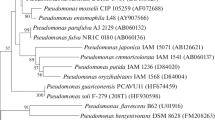Abstract
Pseudomonas sp. F12 isolated from soil could transform dl-2-amino-Δ2-thiazoline-4-carboxylic acid (DL-ATC) to l-cysteine. It could grow in minimal medium containing DL-ATC as the sole carbon and nitrogen source, and the apparent activity of l-cysteine synthesis (CS) achieved 122 U/mL in a 5-L bioreactor. Pseudomonas sp. F12 could utilize glucose as carbon source and ammonia as nitrogen source for growth, but no CS activity was formed. To reduce the cost of DL-ATC, the cultivation process was divided into a growth stage on glucose and ammonia and a production stage induced by DL-ATC. The excessive glucose led to the production of byproduct(s) which seriously inhibited cell growth and CS production. Ammonium was accumulated when DL-ATC was consumed, and ammonium did not inhibit CS activity formation until 60 mM. Based on the above features, fed-batch cultivation of the growth stage was developed by supplying glucose restrictively. The volumetric CS activity was enhanced more than two times that obtained under the initial conditions.







Similar content being viewed by others
References
Wada, M., & Takagi, H. (2006). Metabolic pathways and biotechnological production of L-cysteine. Applied Microbiology and Biotechnology, 73, 48–54.
Nakamori, S., Kobayashi, S., Kobayashi, C., & Takagi, H. (1998). Overproduction of L-cysteine and L-cystine by Escherichia coli strains with a genetically altered serine acetyltransferase. Applied and Environmental Microbiology, 64, 1607–1611.
Wirtz, M., & Hell, R. (2003). Production of cysteine for bacterial and plant biotechnology: application of cysteine feedback-insensitive isoforms of serine acetyltransferase. Amino Acids, 24, 195–203.
Wada, M., Awano, N., Haisa, K., Takagi, H., & Nakamori, S. (2002). Purification, characterization and identification of cysteine desulfhydrase of Corynebacterium glutamicum, and its relationship to cysteine production. FEMS Microbiology Letters, 217, 103–107.
Hsiao, H. Y., & Wei, T. (1987). Enzymatic synthesis of L-cysteine. Biotechnology and Bioengineering, 30, 875–881.
Kumagai, H., Tanaka, H., Sejima, S., & Yamada, H. (1977). Elimination and replacement reactions of β-chloro-L-alanine by cysteine desulfhydrase from Aerobacter aerogenes. Agricultural Biology and Chemistry, 41, 2071–2075.
Sano, K., Yokozeki, K., Tamura, F., Yasuda, N., Noda, I., & Mitsugi, K. (1977). Microbial conversion of DL-2-amino-delta2-thiazoline-4-carboxylic acid to L-cysteine and L-cystine: screening of microorganisms and identification of products. Applied and Environmental Microbiology, 34, 806–810.
Tamura, Y., Nishino, M., Ohmachi, T., & Asada, Y. (1998). N-Carbamoyl-L-cysteine as an intermediate in the bioconversion from D,L-2-amino-Δ2-thiazoline-4-carboxylic acid to L-cysteine by Pseudomonas sp. ON-4a. Bioscience, Biotechnology, and Biochemistry, 62, 2226–2229.
Ryu, O. H., & Shin, C. S. (1991). Analysis of the reaction steps in the bioconversion of D, L-ATC to L-cysteine. Journal of Microbiology and Biotechnology, 1, 50–53.
Shahinian, A. H., & Reinhold, J. G. (1971). Application of the phenol—hypochlorite reaction to measurement of ammonia concentrations in Kjeldahl digests of serum and various tissues. Clinical Chemistry, 17, 1077–1080.
Huai, L. H., Chen, N., Yang, W. B., & Bai, G. (2008). Metabolic control analysis of L-cysteine producing strain TS1138 of Pseudomonas sp. Biochemistry (Moscow), 74, 288–292.
Gaitonde, M. K. (1967). A spectrophotometric method for the direct determination of cysteine in the presence of other naturally occurring amino acids. The Biochemical Journal, 104, 627–636.
Landwall, P., & Holme, T. (1977). Removal of inhibitors of bacterial growth by dialysis culture. Journal of General Microbiology, 103, 345–352.
Yu, Y. S., Liu, Z., Liu, C. Q., Li, Y., Jin, Y. J., Yang, W. B., et al. (2006). Cloning, expression, and identification of genes involved in the conversion of DL-2-amino-Δ2-thiazoline-4-carboxylic acid to L-cysteine via S-carbamyl-L-cysteine pathway in Pseudomonas sp. TS1138. Bioscience, Biotechnology, and Biochemistry, 70, 2261–2267.
Tamura, Y., Ohmachi, T., & Asada, Y. (2001). Induction of 2-amino-Δ2-thiazoline-4-carboxylic acid hydrolase and N-carbamoyl-L-cysteine amidohydrolase by S-compounds in Pseudomonas putida AJ3865. The Journal of General and Applied Microbiology, 47, 193–200.
Landwall, P., & Holme, T. (1977). Influence of glucose and dissolved oxygen concentrations on yields of Escherichia coli B in dialysis culture. Journal of General Microbiology, 103, 353–358.
Doelle, H. W., Ewings, K. N., & Hollywood, N. W. (1982). Regulation of glucose metabolism in bacterial systems. Advances in Biochemical Engineering, 23, 1–35.
Shiloach, J., Kaufman, J., Guillard, A. S., & Fass, R. (1996). Effect of glucose supply strategy on acetate accumulation, growth, and recombinant protein production by Escherichia coli BL21 (λDE3) and Escherichia coli JM109. Biotechnology and Bioengineering, 49, 421–428.
El-mansi, E. M. T., & Holms, W. H. (1989). Control of carbon flux to acetate excretion during growth of Escherichia coli in batch and continuous cultures. Journal of General Microbiology, 135, 2875–2883.
Lee, J., Lee, S. Y., Park, S., & Middelberg, A. P. (1999). Control of fed-batch fermentations. Biotechnology Advances, 17, 29–48.
Yamane, T., & Shimizu, S. (1984). Fed-batch techniques in microbial processes. Advances in Biochemical Engineering/Biotechnology, 30, 147–194.
Dilworth, M. J., Mckay, I., Franklin, M., & Glenn, A. R. (1983). Catabolite effects on enzyme induction and substrate utilization in Rhizobium leguminosarum. Journal of General Microbiology, 129, 359–366.
Acknowledgments
This work was supported by the “863” Program of China, grant No. 2011AA02A203.
Author information
Authors and Affiliations
Corresponding authors
Rights and permissions
About this article
Cite this article
Fan, C., Li, Z. & Ye, Q. Two-Stage Cultivation of Pseudomonas sp. F12 for the Production of Enzymes Converting dl-2-Amino-Δ2-thiazoline-4-carboxylic Acid to l-Cysteine. Appl Biochem Biotechnol 168, 1867–1879 (2012). https://doi.org/10.1007/s12010-012-9903-5
Received:
Accepted:
Published:
Issue Date:
DOI: https://doi.org/10.1007/s12010-012-9903-5




